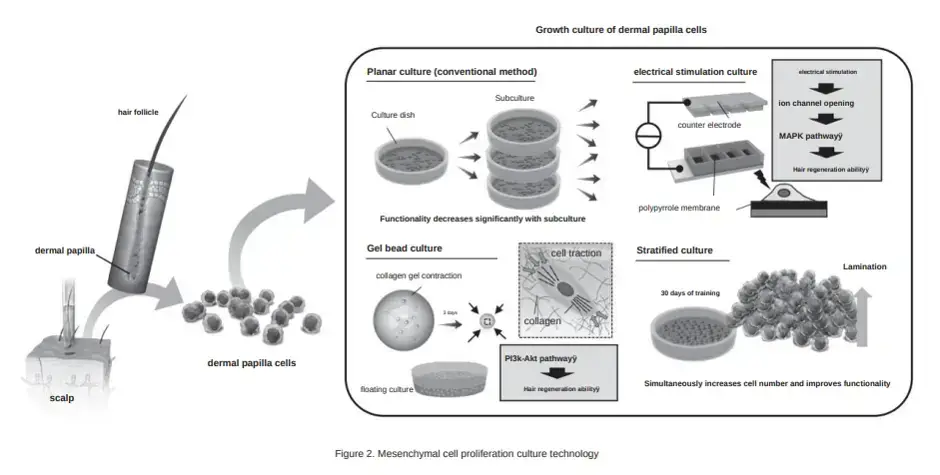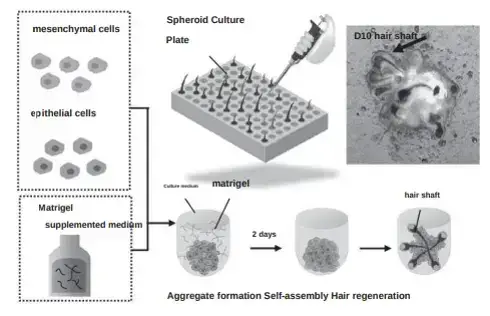Recently, Yokohama National University (Japan)’s Dr. Tatsuto Kageyama published a very lengthy and detailed paper in a Japanese scientific journal called Journal of the Society of Bioengineering. Dr. Kageyama works at the renowned Fukuda Lab in Japan, which is led by Dr. Junji Fukuda. The actual paper is in Japanese and is titled: “Bioengineering approaches for hair follicle regeneration.”
I have translated it and will break out the main details in this post. Besides discussing his team’s scientific approach to hair regrowth, Mr. Kageyama also outlines their overall progress and future plans (though he gives on exact dates for clinical trials). Make sure to check out the diverse range of Google Scholar citations for Mr. Kageyama. In most of his important hair growth related papers, he is a co-author with Dr. Fukuda and others.
Previously, I also mentioned that Ayaka Nanmo, Tatsuto Kageyama and Junji Fukuda are co-founders of a new company named TrichoSeeds. It aims to provide “hair regeneration medicine.”
Bioengineering Approaches for Hair Regeneration
To start off, Mr. Kageyama outlines the three main methods of hair regeneration that his team at Fukuda Lab is working on:
- Mesenchymal cell transplantation. Reactivates existing weakened hair follicles by injecting mesenchymal stem cells.
- Hair follicle primordium transplantion. See their pending patent on hair follicle primordia.
- Hair follicle regeneration. The creation of brand new hair follicles in those who have none left. See their January 2024 study on the large-scale preparation of hair follicle germs (HFGs). The transplantation of HFGs in mice resulted in highly efficient “de novo” hair follicle regeneration.

I am most excited about the first method for now since it will come to market first. Especially in aging Japan, where autologous regenerative medicine treatments are going to be speed tracked to in-clinic use. In fact in my recent post titled “A Visit to Fukuda Lab“, Dr. Junji Fukuda had the following quote:
“Dermal papilla cell transplantation is about to begin in Japan.“
If you have a reasonable amount of your own scalp hair remaining, this mesenchymal stem cell injection treatment sounds very promising. The diagram below that Mr. Kageyma published in his new paper is extremely detailed.
Techniques for Culturing Dermal Papilla Cells
Mr. Kageyama discusses his team’s three unique approaches to culturing dermal papilla cells. I covered these methods in various posts and updates related to Dr. Junji Fukuda’s published papers over the past decade.
The conventional dermal papilla culturing method (number 1 below) is similar to Shiseido’s work, which Mr. Kageyama discusses briefly. He says that it has limited effectiveness, since the hair regeneration ability of the cells is reduced during the process of growing mesenchymal cells in a culture dish.
- Conventional culturing.
- Gel bead culture.
- Electrical stimulation culture.
- Startified culture.

Hair Regeneration by Transplantation of Hair Follicle Primordia
In this second key approach, the aim is to increase the total number of existing hairs. Dr. Kageyama also discusses the work of Dr. Takashi Tsuji and his team in this section of the paper.
The gist of this technology is the mixing of epithelial cells and mesenchymal cells into a single aggregate. This in turn results in the formation of hair follicle primordia (hair seeds), which can then be transplanted into thinning areas of the scalp. The Fukuda team has already succeeeded in the large-scale preparation of hair follicle
primordia.
At present, the team is conducting experiments in transplanting human hair follicle primordia into mice and improving the regeneration efficiency. At present, there is no guarantee that hair follicle will regenerate from the transplanted seeds. It is also difficult to control the direction of new hair growth with this approach.
Hair Follicle Regeneration
The third and final approach entails the creation of brand new hair follicles for transplantation. i.e., hair multiplication. The Fukuda Lab team has managed to develop a culturing technique for regenerating hair follicles in vitro. The discussion here is fairly technical, so I will just quote (and hope that the translation is accurate):
“Focusing on the self-organization process of epithelial cells and mesenchymal cells, we regenerate mature hair follicles with high efficiency (>99%) by controlling the spatial arrangement pattern of aggregates that form in the early stage of culture. Controlling the spatial arrangement of epithelial cells and mesenchymal cells in the aggregate on the second day of culture from a dumbbell shape to a core-shell shape was the key to in vitro hair regeneration. The production method is very simple, such as adding approximately 2% Matrigel to the culture medium when seeding epithelial cells and mesenchymal cells.”

Future Plans
The team plans to continue its work in all three approaches to hair regeneration. i.e., transplantation of mesenchymal cells,
transplantation of hair follicle primordia, and transplantation of regenerated hair follicles. Moreover, they have succeeded in constructing microtweezers that can grasp, cryopreserve, and eject hair follicle primordia. They are also working with robotics experts to develop a fully automated transplantation robot.
How long will it take for this therapy to be commercialized? The last post on this blog about Dr. Fukuda’s work mentioned deadlines between 5 and 10 years…
Why don’t they start clinical trials for the 3rd technique if, as it says in the quote, “the production method is very simple”? In the last update, they said it would take more than 10 years… That makes me wonder if it is as easy as they pretend it.
I think this 3rd technique would be the ultimate cure if they can produce enough of those follicles, but we are a bit lost with the japanese companies in the field ( i.e : no precise dates, claiming it is simple but stating it is 10+ years away). It is unfortunate because japan regulations are more flexible than FDA. I really hope the japan companies succeed but i think the cure is going to come from Stemson. Their pathway towards clinical trials is clearer and they have been more transparent with us, they explicitly said that they plan on using their technology for transplants and they are backed up by a big team of scientists/researchers. Also, they plan on making it available for the average consume.
I’m hoping that the use of IPSC’s is shown to be safe and effective and that the path through FDA regulations will be as smooth as we all dream of.
I wonder what the time frame is like
“ If you have a reasonable amount of your own scalp hair..”
What’s a reasonable amount? I know, hard to say. But I think many will be right on the fence with this. Some hair…but obviously not too much of they wouldn’t be interested.
Great summary admin, thanks for that.
I‘m a huge fan of their work, but the speed of development is astonishingly slow.
Let’s see if they stick to their word and start trials this year – the same applies to Tsuji and Epibiotech…many years of promising research, big announcements and countless delays – I think it’s time to deliver or they have to be called out.
At the moment it seems Stemson is the best bet. Especially the Aderans-method could be the first one out.
Do you think Stemson and the Aderans technique will be on the market before Tsuji Ben? If Tsuji begins clinical trials this year, I think that 2026 is not a crazy date for it to be available, but you are right in that there are many years of research by these companies that later do not materialize into anything concrete. I also think that if Stemson resumes clinical trials of Aderans in phase 3 it could arrive sooner, but when will the trials begin? We don’t know either. And HairClone, you are also right in that they have been saying for years that their technique would be available in 2020, then in 2022, now in 2025… Let us remember that at this moment all these companies are focused on the same thing, the multiplication and injection of the Autologous dermal papilla cells. At this point and with all the supposed research in the past, it was assumed that this would be very very close to the market but no one tells us a specific date. This morning I saw news that in 2026 there would be 10 clinics in Spain that would treat cancer non-invasively, attacking only cancerous tissues, with much fewer side effects. It seems that science is advancing but in the world of hair we still have no solution…
If they resume with phase 3 and not phase 2, then I think Aderans could be available in 2026.
I also think they will start with the trials this year – according to Hamilton the first talks with ARI started in 2022, so they had a full 2 years to evaluate the tech and legal framework. I am actually the most optimistic about this method in terms of timeline and efficacy.
OrganTech sure, let’s see. Kondo clearly said Q2/2024. That’s very precise, I doubt they will start soon. Just a gut-feeling. Hopefully this year though.
Just a comment to show support for this website. This type of detailed update is sincerely appreciated. Still hoping for Hair Loss Cure 2020s
(the “s” means we could still be right, realistically) :-)
Thanks :-)
Between 2030 and 2035 !
I don’t see it, is there an update?
Hi Ben,
After I published this post in early May, I had to post new updates to three other posts (Epibiotech, JW Pharmaceuticals and Pelage). So this post did not stay on the home page for more than a couple of days.
So no new updates per se.
Admin any insight to my question below?
George, if you read all my recent updates on Stemson and watch the videos, it should give some ideas on estimates.
It is spelled “Stemson” and not “Stempson”, in case you are searching.
Admin when in your perspective would stempson release if all goes to plan.
No one knows.
OMG , I used to visit this website in 2014 and I was like you guys thinking that we will have a cure or new treatment, but after few years of following this website I knew that this will never happen and I am here after 10 years and I was right , miss u admin and great job as always, keep up the good work.
Eventually it will happen, one way or another.
It could be multiple treatments that compliment each other, or one that does it all.
There’s never been so much money in hairloss R&D and never so many promising candidates. Some are in clinical trial phase 2 or even 3 at the moment.